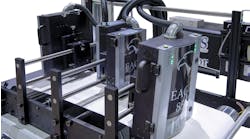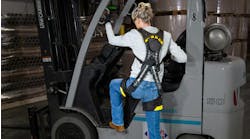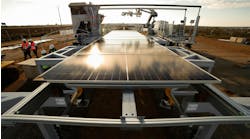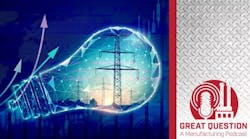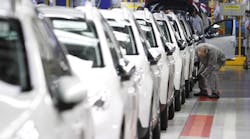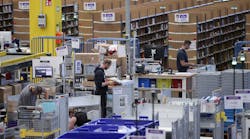In 2021, as COVID-19 strained global supply chains, manufacturers faced worsening environmental conditions including flooding, drought, and destructive storms. These concerns can be connected.
Manufacturers seeking to reshore supply chains have the simultaneous opportunity to consider new and more environmentally friendly options, speaking to consumers’ increasing awareness and sensitivity toward environmental concerns.
What changes to the state of supply chain concerns and what opportunities for sustainability might we see in 2022?
End of Supply Chain Woes in Sight
“We’ve seen costs skyrocket on labor rates, container shipping, and manufacturing parts. As a result of wage pressures and high demand for shipping, inflation will continue to rise and supply chains will struggle through the first two-to-three quarters of 2022,” says Bruce Lancaster, CEO at Wilson Electronics.
“I expect disruption to continue into 2022 as companies shift from ’just-in-time’ strategies of efficiency to ’just-in-case’ strategies—building up inventory to accommodate disruptions and better prepare for future unknowns,” says John McEleney, corporate vice president of Strategy for OnShape. “However, operations will start to normalize by Q3 as a result of new government fundingand private-public partnerships.”
“The pandemic has exposed the risks of the long-standing ‘just-in-time manufacturing’ model where items are created to meet demand to avoid having a surplus,” says Brett Chouinard, CTO at Altair. “While some areas of the global supply chain will improve in 2022, other segments may get even worse, forcing organizations to seek new approaches and potentially partner across industries to gain more control over the supply chain at local levels.”
“Companies will start to use data much more to inform decisions around where to build their supply chains both today and into the future, so there is less opportunity for their supply chains to be disrupted,” says Agnes Schliebitz-Ponthus, senior vice president of product at Fluent Commerce.
“One of the most glaring issues the electronic supply chain needs to reconcile is forecasting demand horizontally and vertically. Inaccurate demand signals and data reverberate throughout the entire supply chain ecosystem and make it difficult for companies to forecast growth and predict what type of associated support investments they need to make,” says Lynn Torrel, chief procurement and supply chain officer at Flex.
“In 2022, we expect supply chain professionals to work together towards a solution that improves the overall system without diminishing their organization’s competitiveness,” Torrel continues. “OEMs, electronic manufacturing services, distributors and suppliers are all interested in receiving accurate demand information, based on which they can plan, and success requires the leading players in the ecosystem to participate.”
“As we enter 2022, I believe we’ll continue to see additive manufacturing play a critical role in transforming manufacturing workflows and supply chains,” says Dr. Jeffrey Graves, president & CEO at 3D Systems. “Significant delays in logistics are hampering organizations’ ability to deliver products and services in a timely fashion. Being able to manufacture all critical components at the point of assembly or point of care can streamline these activities.”
Green Manufacturing Policies Will Continue
“While ESG (environmental, social and governance) sourcing has always been a topic of discussion, often driven by social sentiments, it is now being solidified as a board agenda requiring a systematic vision and roadmap,” says Dave Lewis, partner, ISG manufacturing and automotive practice, from technology research and advisory firm ISG. “Industry 4.0 represents an excellent opportunity to boost sustainable manufacturing—by focusing on utilizing and scaling new technologies in the manufacturing process that immediately improves system efficiency and consequently reduces resource consumption with the combined effect of fewer losses, less waste, and lower resource depletion.
The idea of the circular economy, a model that embraces recycling, repairing, and reusing materials for as long as possible, may grow more attractive and commonplace as sustainability concerns grow.
“Measurement, transparency, and commercial balance, as well as the introduction of circular economy models into enterprises supply chains, will pave the path towards a successful carbon-reduced footprint and fulfillment of ESG targets,” Lewis continues. “Anticipate increased investment into sustainable manufacturing in 2022.
“As businesses and organizations start looking hard at their sustainability strategy, setting targets for lowered emissions, zero waste, water management and more, the circular economy will emerge as the strongest way to get them there,” says Kyra Whitten, vice president of Communications and Sustainability at Flex.
“To meet net zero goals by 2030 or 2040 and meet demand from consumers who are calling for more sustainable products, it will become more important than ever to extend the life of products through strong circular economy practices,” Whitten continues. “This kind of infrastructure has the potential to make the biggest impact on sustainability goals in the year to come. “
“The speed of deployment for renewable energy will outpace other energy sources in 2022 and beyond driven by new investments, innovation, increased competition, and policy support in the U.S. and the EU,” says Michael Bates, global general energy manager at Intel. “This year, we saw more frequent severe weather events around the globe due to the impacts of climate change. To mitigate these impacts, we need an energy grid that can better support the rise in renewable energy and create a clean energy future.”
“I also expect we’ll see increased government spending on sustainable infrastructure, smart grids, water management, and electric vehicles,” Bates continues. “My hope is that 2022 is the year that the transition to renewable energy really starts to take off. It’s one of the most important things for our future.”

